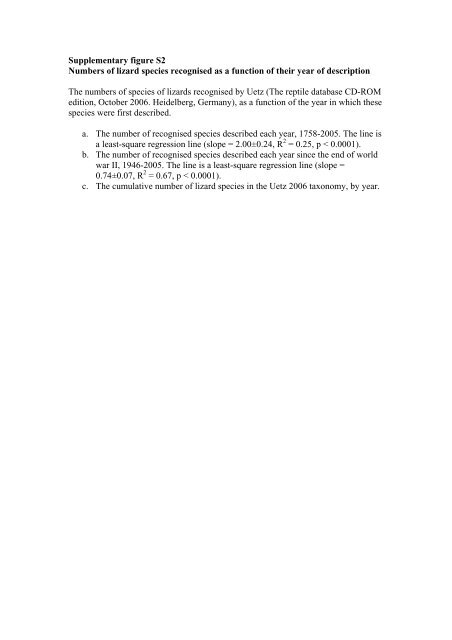- Page 1 and 2:
Global Ecology and Biogeography, (G
- Page 3 and 4:
S. Meiri obscure rather than clarif
- Page 5 and 6:
S. Meiri Table 1 Body size of lizar
- Page 7 and 8:
S. Meiri Figure 4 Body size-frequen
- Page 9 and 10:
S. Meiri with more than 100 species
- Page 11 and 12:
S. Meiri Sokol, O.M. (1967) Herbivo
- Page 13 and 14:
paper 1 Abdala, C. S. 2002. Nuevo L
- Page 15 and 16:
68 Axtell, R. W., and Axtell, C. A.
- Page 17 and 18:
126 Bedriaga, J. V. 1884. Die neue
- Page 19 and 20:
192 Boulenger, G. A. 1903. Descript
- Page 21 and 22:
262 Cadle, J. E. 2001. A new specie
- Page 23 and 24:
324 Cogger, H., Sadlier, R., and Ca
- Page 25 and 26:
390 Das, I. and Bauer, A. M. 1998.
- Page 27 and 28:
456 Dunger, G. T. 1967. The lizards
- Page 29 and 30:
524 Gao, Z-F. and Huo, M. 2002. Des
- Page 31 and 32:
597 Gunther, A. 1893. Report on a c
- Page 33 and 34:
670 Ineich, I., and Chirio, L. 2004
- Page 35 and 36:
734 Kohler, G., McCranie, J. R. and
- Page 37 and 38:
808 Lobo, F. and Quinteros, S. 2005
- Page 39 and 40:
873 Medica, P. A. 1967. Food Habits
- Page 41 and 42:
936 Necas, P., Modry, D. and Slapet
- Page 43 and 44:
998 Parker, H. W. 1932. Two collect
- Page 45 and 46:
1068 Qualls, C. P., Shine, R. Donne
- Page 47 and 48:
Roll, B. 2000. Two sympatric Lygoda
- Page 49 and 50:
Scolaro, J. A. and Cei, J. M. 1997.
- Page 51 and 52:
Sternfeld, R. 1912. IV. Zoologie II
- Page 53 and 54:
1344 Uetz, P. 2006. The reptile dat
- Page 55 and 56:
Vitt, L. J., Souza, R. A., Sartoriu
- Page 57 and 58:
1467 Yang, R. 1983. A new species o
- Page 59 and 60:
Family Taxon Species SVL (mm) Remar
- Page 61 and 62:
Agamidae Agamidae Diporiphora_benne
- Page 63 and 64:
Agamidae Agamidae Laudakia_nupta 17
- Page 65 and 66:
Agamidae Agamidae Trapelus_lessonae
- Page 67 and 68:
Anguidae Anguidae Mesaspis_antauges
- Page 69 and 70:
Chamaeleonidae Chamaeleonidae Chama
- Page 71 and 72:
Cordylidae Cordylidae Platysaurus_m
- Page 73 and 74:
Gekkonidae Gekkoninae Chondrodactyl
- Page 75 and 76:
Gekkonidae Gekkoninae Cyrtodactylus
- Page 77 and 78:
Gekkonidae Gekkoninae Geckoella_yak
- Page 79 and 80:
Gekkonidae Gekkoninae Hemidactylus_
- Page 81 and 82:
Gekkonidae Gekkoninae Lepidoblephar
- Page 83 and 84:
Gekkonidae Gekkoninae Matoatoa_span
- Page 85 and 86:
Gekkonidae Gekkoninae Phelsuma_mada
- Page 87 and 88:
Gekkonidae Gekkoninae Ptychozoon_tr
- Page 89 and 90:
Gekkonidae Gekkoninae Sphaerodactyl
- Page 91 and 92:
Gerrhosauridae Gerrhosauridae Zonos
- Page 93 and 94:
Gymnophthalmidae Gymnophthalmidae M
- Page 95 and 96:
Iguanidae Iguanidae Ctenosaura_oedi
- Page 97 and 98:
Lacertidae Lacertidae Eremias_scrip
- Page 99 and 100:
Lacertidae Lacertidae Pedioplanis_b
- Page 101 and 102:
Phrynosomatidae Phrynosomatidae Sce
- Page 103 and 104:
Polychrotidae Polychrotidae Anolis_
- Page 105 and 106:
Polychrotidae Polychrotidae Anolis_
- Page 107 and 108: Polychrotidae Polychrotidae Norops_
- Page 109 and 110: Polychrotidae Polychrotidae Pristid
- Page 111 and 112: Scincidae Scincidae Asymblepharus_a
- Page 113 and 114: Scincidae Scincidae Cophoscincopus_
- Page 115 and 116: Scincidae Scincidae Ctenotus_youngs
- Page 117 and 118: Scincidae Scincidae Emoia_slevini 8
- Page 119 and 120: Scincidae Scincidae Lampropholis_ca
- Page 121 and 122: Scincidae Scincidae Lerista_yuna 66
- Page 123 and 124: Scincidae Scincidae Melanoseps_love
- Page 125 and 126: Scincidae Scincidae Parvoscincus_si
- Page 127 and 128: Scincidae Scincidae Scincella_ladac
- Page 129 and 130: Scincidae Scincidae Sphenomorphus_m
- Page 131 and 132: Scincidae Scincidae Trachylepis_vit
- Page 133 and 134: Teiidae Teiidae Cnemidophorus_gular
- Page 135 and 136: Tropiduridae Liolaemidae Liolaemus_
- Page 137 and 138: Tropiduridae Liolaemidae Liolaemus_
- Page 139 and 140: Tropiduridae Tropidurinae Stenocerc
- Page 141 and 142: Xantusiidae Xantusiidae Lepidophyma
- Page 143 and 144: Family Species Max SVL (mm) sources
- Page 145 and 146: Gekkonidae Hoplodactylus cryptozoic
- Page 147 and 148: Scincidae Eumeces humilis 73.0 Boul
- Page 149 and 150: paper Abdala, C. S. 2005. Dos nueva
- Page 151 and 152: Grismer, L. L. 2006. Two new specie
- Page 153 and 154: Tri, N. V. and Bauer, A. M. 2008. D
- Page 155 and 156: Chamaeleonidae Agaminae Uromastycid
- Page 157: Supplementary figure S1 Body size f
- Page 161: Number of lizard species recognized

















